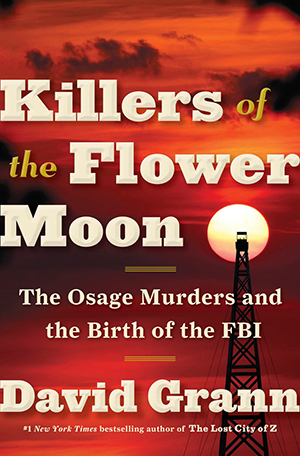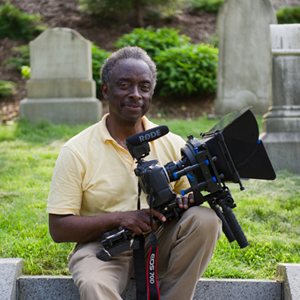David Grann knew he’d discovered a story worth telling when he found himself face-to-face with a photograph of evil.
Grann (GRS’94), a New Yorker staff writer, first visited the Midwestern Native American tribe Osage Nation on a tip from the FBI—there was an old murder case, widely forgotten, that a historian at the bureau thought might interest him. He began his research at Oklahoma’s Osage Nation Museum, where one wall was covered with a 1924 panoramic photo of hundreds of tribe members. In one corner, part of the photograph had been ripped away. He asked the museum director, a tribe member, why.
“She said, ‘The devil was standing right there,’” Grann recalls. “I thought, I have to know more about this.”
That torn photo launched Grann’s new book, Killers of the Flower Moon: The Osage Murders and the Birth of the FBI (Doubleday, 2017), which unmasks a crime with few parallels in American history and a forgotten chapter of that history.
In the 1920s the Osage leased the drilling rights to the oil beneath their reservation, and quickly became the richest people per capita in the world. Then, tribe members started dying in a series of horrific murders. Grann, best known for his 2010 adventure-in-the-Amazon narrative The Lost City of Z, spent years researching the strange confluence of events that led to the Osage deaths and the conviction of a prominent white citizen.
“It’s a microcosm of the forces of original sin from which this country was born,” Grann says. “The clashing of two civilizations, and the taking of land.”
The story of the Osage oil boom captivated the country from the start: banished from their lands in the 1870s, the tribe was relegated to rocky, infertile terrain in Oklahoma. The tribe’s leaders, informed by years of dealings with the US government, negotiated to purchase their land and to retain ownership of any mineral deposits beneath it. They devised an inheritance system known as headrights to ensure the rights to the oil would remain with the Osage.
When oil reserves were discovered beneath the land, the Osage become millionaires. Tribe members moved into mansions, bought fancy cars, and hired white servants. Tabloids across the country christened them the “red millionaires,” and they spread apocryphal tales of the Osage squandering their newfound wealth.
In response, Congress passed a law prohibiting the Osage from managing their own money; instead, they were made wards of white guardians, who were in charge of their financial decisions. Headrights were supposed to offer some protection for the tribe, but, as Grann recounts, they made them targets. The only way to gain control of the assets was to become a member of an Osage family, and white men suddenly started courting Osage women.
Enter the devil in the picture: William Hale, a prominent white townsman and trusted adviser to many Osage—hence his presence in the museum’s panoramic photo. Hale used his standing in the frontier town to manipulate one Osage family for his own gain. He encouraged one of his nephews to marry an Osage woman, and he masterminded her two sisters’ deaths to leave his nephew the direct heir to their headrights. His plot was discovered by the FBI before his final intended victim, his nephew’s wife, Mollie Burkhart, succumbed to the slow poisoning that the town’s doctors, under Hale’s influence, neglected to diagnose. After the FBI took over the investigation, Hale was convicted of one murder—the shooting death of Henry Roan, Mollie Burkhart’s ex-husband—and served 20 years of a life sentence.
The five years between the first known murder and Hale’s conviction became known among the tribe as the Reign of Terror: in addition to the murders connected to the Burkhart family, many other Osage, as well as several white citizens advocating for further investigation, were killed or died of mysterious causes during that time. But after Hale’s parole and release, those cases were never pursued, and the episode was largely forgotten beyond the borders of the Osage Nation.
“I wanted to understand who this figure was,” Grann says. “The Osage had removed his picture because they could not forget what had happened, but so many Americans, including me, had already forgotten.”
As Grann began piecing together the components of the crime, it became clear just how unusual and compelling this case was. To pull off a crime of this scale involved not simply joining an Osage family, but relying on the complicity of local law enforcement and other leading citizens, such as doctors, to perpetuate false theories and fake leads. “This country was so lawless, even in the 1920s,” Grann says. “There were payoffs, there was corruption, and the murders went on and on.”
To trace the evolution of the crime and its investigation, Grann focuses his narrative on two principal figures: Burkhart, the woman whose family was targeted by Hale, and Tom White, the FBI field agent who ultimately cracked the case. Both, Grann says, turned out to be emblematic of the transitional moment in American history. Burkhart had grown up in a lodge, in the traditional Osage culture, and by adulthood was living in a mansion, married to a white man, and employing white servants. White was a log-cabin-born frontiersman who learned new law enforcement techniques, ranging from fingerprinting and toxicology to detailed record-keeping, as he rose through J. Edgar Hoover’s fast-growing FBI.
“This is the birth of a modern country,” Grann says. “Mollie Burkhart is straddling two centuries and two civilizations. Tom White is a transitional figure from a period of frontier justice to the big force transforming the country: professionalism.”
The same modernization that made the case momentous also ensured that it would be quickly forgotten outside of Indian territory. Across the nation, the Great Depression turned the oil boom into a bust. The FBI redirected its resources to Hoover’s highly publicized “War on Crime,” targeting Chicago’s gangster element. A blatant lack of interest in the murders of American Indians was another powerful factor; Grann quotes one of Hale’s hired guns, who shot Henry Roan, as saying that even in the 1920s, “white people in Oklahoma thought no more of killing an Indian than they did in 1724.”
Grann, who began this book not long after publishing The Lost City of Z (released as a major motion picture this year), says he’s drawn to stories with mystery and that offer the opportunity to explore larger themes about history and human nature. But embarking on any project of this scope also requires “a quality that’s less rational,” he says, “where there’s something inside you that makes you need to tell it.” Throughout his four years of research for Killers of the Flower Moon, Grann discovered something else that made him want to stick with this story: a sense of moral obligation.
In his visits to the present-day Osage Nation, Grann writes that he learned why the Osage cannot forget: there were “countless other killings” among families, unconnected to Hale, and mostly never reported or investigated. Concluding the project, he says, gave him a full understanding of the tragedy’s scope: it encompasses “the horror of what you know, and the horror of what you don’t know.”

















































After the preview in Bostonia, I read Mr. Grann’s book documenting the horrific abuses received by the Osage Indians in two sittings – not that it was an easy read, I just could not put the book down. I am not sure if I am more disgusted by the manipulation by the local upstanding citizens who may have murdered well over a hundred Osage Indians to get access to their oil rights or by Congress who asserted the Osage were incompetent until proven otherwise. I was impressed by the dogged pursuit of information by Mr. Grann to bring to light a long forgotten tragedy. Well done Sir~